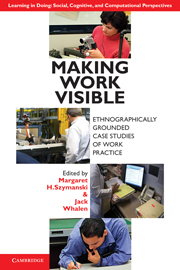Book contents
- Frontmatter
- Contents
- List of Figures and Excerpts
- List of Tables
- List of Contributors
- Series Foreword
- Foreword by John Seely Brown
- Acknowledgments
- Introduction
- Part I Work Practice Study in Historical Context
- Part II Applying Work Practice Methods
- Part III Practices around Documents
- 6 Exploring Documents and the Future of Work
- 7 New Ways of Working
- 8 Behind the Scenes
- 9 Seeing the Right Color
- Part IV The Customer Front
- Part V Learning and Knowledge Sharing
- Part VI Competency Transfer
- References
- Index
- LEARNING IN DOING: SOCIAL, COGNITIVE AND COMPUTATIONAL PERSPECTIVES
8 - Behind the Scenes
The Business Side of Medical Records
Published online by Cambridge University Press: 05 August 2012
- Frontmatter
- Contents
- List of Figures and Excerpts
- List of Tables
- List of Contributors
- Series Foreword
- Foreword by John Seely Brown
- Acknowledgments
- Introduction
- Part I Work Practice Study in Historical Context
- Part II Applying Work Practice Methods
- Part III Practices around Documents
- 6 Exploring Documents and the Future of Work
- 7 New Ways of Working
- 8 Behind the Scenes
- 9 Seeing the Right Color
- Part IV The Customer Front
- Part V Learning and Knowledge Sharing
- Part VI Competency Transfer
- References
- Index
- LEARNING IN DOING: SOCIAL, COGNITIVE AND COMPUTATIONAL PERSPECTIVES
Summary
In 2007, Electronic Medical Records (EMR) systems, though not new, were clearly the future. Yet, most medical records in U.S. physicians' offices were on paper. Hing et al. (2007) report that only 29.2% of 2,117 survey respondents had any EMR system and only 12.4% had fully implemented an EMR system (i.e., no part was paper). An earlier study found that EMR use was higher in hospital Emergency Departments (31%) and Outpatient Departments (29%) than in physician practices (17%) (Burt and Hing, 2005), but penetration was low in all areas.
Many have studied EMR systems and their use in doctor–patient interactions. Heath and Luff (1996) found that medical practitioners continued to use paper records along with a newly introduced EMR. Other studies (Clarke et al., 2001) have examined the use of an EMR in medical exams and issues an EMR poses in physician–patient interactions (Ventres et al., 2005). Martin et al. (2005) studied the issues involved in the integration and implementation of an EMR system in a large hospital. Workflow changes required by physicians using an EMR have also been discussed (Puffer et al., 2007). Fitzpatrick (2000) studied the implications of the use of paper records for EMR systems from the point of view of the providers. No studies focused on the work of practice management.
Practice management deals with the business side of the clinic arranging interactions between the patients and clinical staff and insures payment for those interactions.
- Type
- Chapter
- Information
- Making Work VisibleEthnographically Grounded Case Studies of Work Practice, pp. 147 - 159Publisher: Cambridge University PressPrint publication year: 2011
- 4
- Cited by

